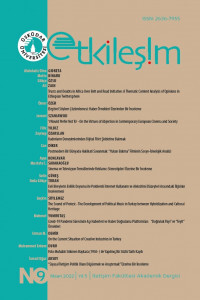Gentrification in Istanbul: Generating Insights Through Photography
Gentrification is a process that describes the regeneration of run-down districts of a city; people from high income groups move into an area and, over time, the original residents move out. This process can be seen in Istanbul during the 1980s when some buildings in the central areas of the city were restored and are now used by people of upper social classes, income groups, cultures and lifestyles. Slum clearance programmes and the building of new apartment blocks has resulted in the gentrification of many parts of the city. This study focuses on one district of Istanbul that has been affected by this type of gentrification. The purpose of the study was to explore what role photography might have in developing an understanding of the gentrification process. The research included a photo-elicitation exercise with some of the residents to understand the effect of gentrification on their lives. This paper outlines the context around gentrification, the methodology employed by the researcher and the findings from the study. The study concludes that visual methodologies can provide valuable data, giving a better understanding of the process and impact of gentrification in Turkey.
Anahtar Kelimeler:
gentrification, photography, visual methodologies, photo-elicitation
___
- Davidson, M. and Lees, L. (2005). “New-Build “Gentrification” and London’s Riverside Renaissance”. Environment and Planning A. 37(6). 1015-1032.
- Fairclough, C. M. (2017). “A City Transformed: Visualising the Social Effects of Gentrification in One District of Istanbul”. C. Cinar and M. S. Akim (eds.) International Interdisciplinarity in the Arts Symposiums 1: Cinema/Photography,
- Book of Proceedings. (32-44). Istanbul, Turkey: Cinius.
- ___________ (2018). “The Value of Photography as a Methodology within the Social Sciences”. Etkileşim. 1(2). 108-123.
- Glass, R. (1964). “Introduction: Aspects of Change”. Centre for Urban Studies (ed.) London: Aspects of Change. London: MacKibbon and Kee.
- Hammersley, M. and Atkinson, P. (1995). Ethnography Principles in Practice. London: Routledge.
- Harper, D. (1998). “An Argument for Visual Sociology”. Prosser, J. (ed.) Image-Based Research. Padstow: TJ International Ltd.
- ___________ (2012). Visual Sociology. Abingdon: Routledge.
- Islam, T. (2005). “Outside the Core: Gentrification in Istanbul”. Atkinson, R. and Bridge, G. (ed.) Gentrification in a Global Context: The New Urban Colonialism. Taylor & Francis e-Library.
- Lees, L., Slater, T., Wyly, E. (2008). Gentrification. New York: Routledge.
- Mason, J. (2002). Qualitative Researching. London: SAGE Publications.
- Pink, S. (2013). Doing Visual Ethnography. London: SAGE Publications.
- Prosser, P. and Schwartz, D. (1998). “Photographs within the Sociological Research Process”. Prosser, J. (ed) Image-Based Research. Padstow: T J International Ltd.
- Rose, G. (2012). Visual Methodologies. London: SAGE Productions.
- Smith, N. (1982). “Gentrification and Uneven Development”. Economic Geography. 58(2). 139-155.
- Suchar, C. (1997). “Grounding Visual Sociology Research in Shooting Scripts”. Qualitative Sociology. 20(1). 33-55.
- Uzun, C. Nil. (2003). “The Impact of Urban Renewal and Gentrification on Urban Fabric: Three Cases in Turkey”. Tijdschrift voor Economische en Sociale Geografie. 94(3). 363-375.
- ISSN: 2636-7955
- Yayın Aralığı: Yılda 2 Sayı
- Başlangıç: 2018
- Yayıncı: Üsküdar Üniversitesi
Sayıdaki Diğer Makaleler
Tülây ATAY, Belkıs ULUSOY NALCIOĞLU, Suat GEZGİN
Yerel İnternet Gazeteciliği: Çorum Örneği
Sosyal Medya ve Suskunluk Sarmalı: Fikirlerin İfadesi İçin Özgür Bir Alan Vaadi Gerçekleşti mi?
Yeni İletişim Teknolojilerinin Gelişimi Bağlamında Kent
Yeni Medyada Halkla İlişkiler Etiği Mümkün müdür?
‘Ağ Toplumu’nda Farkındalığa Davet Eden Kitap: “İletişim Gücü”
Söylemin Kapatılma ve Açımlama Savaşımında Edward Snowden
Gentrification in Istanbul: Generating Insights Through Photography
